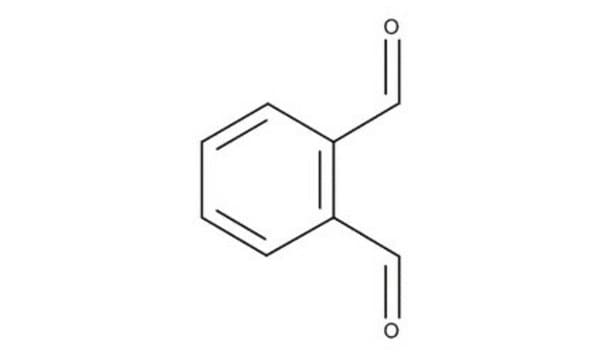1.11452
Phthaldialdehyde
for fluorometry
Sinónimos:
Phthaldialdehyde, OPA
About This Item
Productos recomendados
Quality Level
form
solid
autoignition temp.
480 °C
potency
178 mg/kg LD50, oral (Rat)
>2000 mg/kg LD50, skin (Rat)
pH
7 (20 °C, 53 g/L in H2O)
bp
83-84 °C/1 hPa
mp
52-58 °C
transition temp
flash point 132 °C
solubility
53 g/L
density
1.13 g/cm3 at 20 °C
bulk density
530 kg/m3
storage temp.
2-30°C
InChI
1S/C8H6O2/c9-5-7-3-1-2-4-8(7)6-10/h1-6H
InChI key
ZWLUXSQADUDCSB-UHFFFAOYSA-N
application
- Combined techniques for revealing the mechanism beneath the inhibition effects of pectin on gluten digestibility using static in vitro gastro-duodenal protocols.: This study uses a combination of techniques to explore how pectin affects gluten digestibility, providing insights into the interaction of phthaldialdehyde derivatives with gluten proteins (Lin et al., 2024).
- Analysis of Gizzerosine in Foodstuffs by HPLC Involving Pre-column Derivatization with o-Phthaldialdehyde.: This research develops a method using HPLC with pre-column derivatization involving phthaldialdehyde to analyze gizzerosine in foodstuffs, demonstrating the compound′s utility in food safety studies (Li and Wu, 2024).
- Comprehensive studies on the development of HPLC-MS/MS and HPLC-FL based methods for routine determination of homocysteine thiolactone in human urine.: This study develops and validates methods using phthaldialdehyde derivatives for the determination of homocysteine thiolactone in human urine, contributing to clinical diagnostics and biochemical research (Piechocka and Głowacki, 2024).
- Smart-detection approach for protein residues to evaluate the cleaning efficacy of reusable medical devices.: Utilizing phthaldialdehyde for protein residue detection, this study provides a smart detection approach to improve the cleaning efficacy of medical devices, enhancing patient safety (Ouirungroj et al., 2024).
- One-pot sample preparation procedure for the determination of protein N-linked homocysteine by HPLC-FLD based method.: This research presents a novel one-pot sample preparation method using phthaldialdehyde for determining protein N-linked homocysteine, advancing analytical techniques in protein chemistry (Piechocka and Głowacki, 2023).
Analysis Note
Identity (IR): conforms
Melting point: 54 - 58 °C
Fluorescence (340 nm, 0,8 g/l, ethanol, as quinine): ≤ 2 ppb
Phthalic acid (TLC): ≤ 0.5 %
Nitrogen compounds (as N): ≤ 0.05 %
signalword
Danger
Hazard Classifications
Acute Tox. 3 Oral - Aquatic Acute 1 - Aquatic Chronic 1 - Eye Dam. 1 - Skin Corr. 1B - Skin Sens. 1 - STOT SE 3
target_organs
Respiratory system
Storage Class
6.1A - Combustible, acute toxic Cat. 1 and 2 / very toxic hazardous materials
wgk_germany
WGK 3
flash_point_f
269.6 °F - closed cup
flash_point_c
132 °C - closed cup
Certificados de análisis (COA)
Busque Certificados de análisis (COA) introduciendo el número de lote del producto. Los números de lote se encuentran en la etiqueta del producto después de las palabras «Lot» o «Batch»
¿Ya tiene este producto?
Encuentre la documentación para los productos que ha comprado recientemente en la Biblioteca de documentos.
Los clientes también vieron
Nuestro equipo de científicos tiene experiencia en todas las áreas de investigación: Ciencias de la vida, Ciencia de los materiales, Síntesis química, Cromatografía, Analítica y muchas otras.
Póngase en contacto con el Servicio técnico








